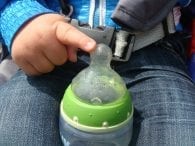Breastfeeding is not an all-or-nothing deal. While many mothers who combine nursing and working do supply all of their baby’s milk feedings for many months, others use formula as a back-up when they are unable to pump enough milk. In other cases, baby nurses at the breast when mother is available and gets formula when she is not.
If this second situation sounds like the direction in which you’re headed, give some thought to how you will combine breastfeeding and formula-feeding. Otherwise, you may discover one day, long before you had planned on weaning, that your baby has lost interest in the breast and you don’t have much milk anyway.
• Even if you are not expressing and saving milk for your baby while you are at work you still may need to do some pumping to prevent plugged ducts and mastitis and to keep up your milk supply. Some mothers can go for four to six hours without nursing or expressing, but many can’t. If you are away from your baby for seven or eight hours, or longer, you will need to pump once or twice even if you don’t save the milk. (We can’t imagine any mother pumping and dumping that “white gold” routinely, but it would be better than not pumping and winding up with too full of breasts and letting your brain get the message that it can stop milk production.)
• Nurse your baby frequently while the two of you are together and avoid long separations other than those related to your job. This includes nursing at night, while you sleep. Give baby lots of skin-to-skin contact and lots of time with you to keep her interested in the breast and to build your prolactin levels.
• If your baby seems to be losing interest in the breast, you may need to encourage her to nurse more frequently. You may also need to do some expressing while the two of you are apart so that there is plenty of milk in the breast when baby wants to nurse.

